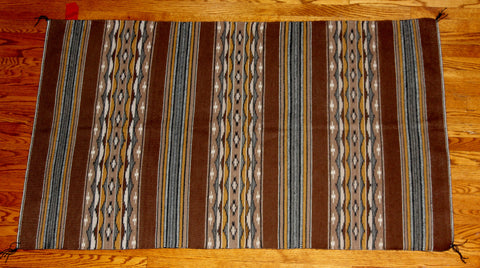
Native American, Exceptional Vintage San Ildefonso Pottery Jar by Blue Corn (1921-1999), Ca 1970's-1980's, #1510 Sold
$ 3,000.00
Native American, Exceptional Vintage San Ildefonso Pottery Jar by Blue Corn (1921-1999), Ca 1970's-1980's, #1510 Sold
Description: #1510 Native American, Exceptional Vintage San Ildefonso Pottery Jar by Blue Corn (1921-1999), Ca 1970's-1980's. Exceptonal fine line poly chrome decorated feather jar, signed on the bottom.
Condition: Excellent for age
Dimensions: 5''x 6''.
"Blue Corn (c. 1920 – May 3, 1999), also known as Crucita Calabaza, was a Native American potter from San Ildefonso Pueblo, New Mexico, in the United States. She became famous for reviving San Ildefonso poly chrome wares and had a very long and productive career.
Her grandmother first introduced her to pottery making at the age of three. Maria Martinez’s sister gave her the name “Blue Corn” during the naming ceremony, which is the Native American tradition of naming a child.
Blue Corn attended school at the pueblo in her early years. She then went to Santa Fe Indian School, which was 24 miles (39 km) from home. While attending school in Santa Fe, her mother and father died, and she was sent to live with relatives in southern California. Here she worked as a maid for a short time in Beverly Hills.
At the age of 20, she married Santiago “Sandy” Calabaza, a silversmith from Santo Domingo Pueblo. Together they settled at San Ildefonso, where she bore and raised 10 children. During World War II, Blue Corn worked as a house cleaner in Los Alamos for the physicist, J. Robert Oppenheimer.
After her first son, Joseph, was born, she returned to pottery making. Santiago quit his job to help her carve, paint and design her pots, and by the late 1960's she had established herself as a leader in poly chrome styles. After her husband died in 1972, her son Joseph began helping her with her pots. During the 1960's and 70's, she conducted many workshops on pottery making in both the U.S. and Canada. Although Blue Corn also made redware and blackware, she is especially noted for her finely polished slips and exhaustive experimentation with clays and colors, producing cream poly chrome on jars and plates. She is particularly well known for her feather and cloud designs.
Blue Corn is known for the re-introduction of poly chrome fine whiteware and has received critical acclaim from several publications including the Wall Street Journal. Her pottery can be found in the Smithsonian Institution and other leading museums throughout America and Europe as well as in private collections. She won more than 60 awards including the 8th Annual New Mexico Governors Award in 1981. This is New Mexico’s greatest recognition of artistic achievement.
She died May 3, 1999 leaving ten children, 18 grandchildren and 12 great-grandchildren.
Publications:
• Allan Hayes and John Blom, 1996, Southwestern Pottery: Anasazi to Zuni
• Peterson, Susan, 1997, Pottery by American Indian Women: The Legacy of Generations
• Schaaf, Gregory, 2000, Pueblo Indian Pottery: 750 Artist Biographies” (Source: Wikipedia)
“Pueblo pottery is made using a coiled technique that came into northern Arizona and New Mexico from the south, some 1500 years ago. In the four-corners region of the US, nineteen pueblos and villages have historically produced pottery. Although each of these pueblos use similar traditional methods of coiling, shaping, finishing and firing, the pottery from each is distinctive. Various clays gathered from each pueblo’s local sources produce pottery colors that range from buff to earthy yellows, oranges, and reds, as well as black. Fired pots are sometimes left plain and other times decorated—most frequently with paint and occasionally with appliqué. Painted designs vary from pueblo to pueblo, yet share an ancient iconography based on abstract representations of clouds, rain, feathers, birds, plants, animals and other natural world features.
Tempering materials and paints, also from natural sources, contribute further to the distinctiveness of each pueblo’s pottery. Some paints are derived from plants, others from minerals. Before firing, potters in some pueblos apply a light colored slip to their pottery, which creates a bright background for painted designs or simply a lighter color plain ware vessel. Designs are painted on before firing, traditionally with a brush fashioned from yucca fiber.
Different combinations of paint color, clay color, and slips are characteristic of different pueblos. Among them are black on cream, black on buff, black on red, dark brown and dark red on white (as found in Zuni pottery), matte red on red, and polychrome—a number of natural colors on one vessel (most typically associated with Hopi). Pueblo potters also produce undecorated polished black ware, black on black ware, and carved red and carved black wares.
Making pueblo pottery is a time-consuming effort that includes gathering and preparing the clay, building and shaping the coiled pot, gathering plants to make the colored dyes, constructing yucca brushes, and, often, making a clay slip. While some Pueblo artists fire in kilns, most still fire in the traditional way in an outside fire pit, covering their vessels with large potsherds and dried sheep dung. Pottery is left to bake for many hours, producing a high-fired result.
Today, Pueblo potters continue to honor this centuries-old tradition of hand-coiled pottery production, yet value the need for contemporary artistic expression as well. They continue to improve their style, methods and designs, often combining traditional and contemporary techniques to create striking new works of art.” (Source: Museum of Northern Arizona)







